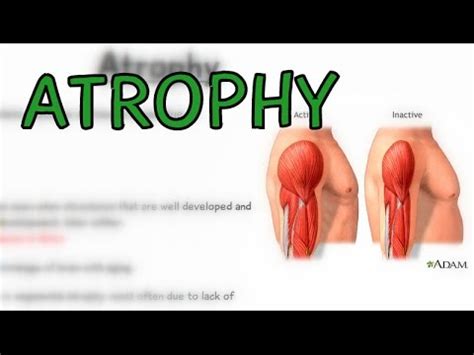
Atrophy
Published Date: 6/17/2023 6:03:56 AM
- Atrophy is defined as a decrease in the size of a tissue or organ due to cellular shrinkage; the decrease in cell size is caused by the loss of organelles, cytoplasm, and proteins.
- The term muscle atrophy refers to the loss of muscle tissue. Atrophied muscles appear smaller than normal. Lack of physical activity due to an injury or illness, poor nutrition, genetics, and certain medical conditions can all contribute to muscle atrophy.
- Muscular dystrophy is a group of inherited diseases characterized by weakness and wasting away of muscle tissue, with or without the breakdown of nerve tissue.
Types of atrophy:
- Muscle atrophy is the wasting or loss of muscle tissue.
- There are two types of muscle atrophy: disuse and neurogenic. The first type of muscle atrophy is disuse atrophy and occurs from a lack of physical exercise. In most people, muscle atrophy is caused by not using the muscles enough.
Several factors can contribute to muscle atrophy, such as:
- remaining immobile for long periods due to illness or injury
- age
- malnutrition
- genetics
- neurological problems
- certain medical conditions, such as arthritis, myositis, ALS, and MS
Treatments:
- Treatments for muscle atrophy vary depending on the degree of muscle loss and the presence of any underlying medical conditions.
- Treating the underlying condition causing muscle atrophy may help slow down the progression of the muscle loss.
- Treatments for muscle atrophy include:
Physical therapy:
Physical therapy involves performing specific stretches and exercises with the aim of preventing immobility. Physical therapy offers the following benefits to people who have muscle atrophy:
- preventing immobility
- increasing muscle strength
- improving circulation
- reducing spasticity, which causes continuous muscle contraction
Functional electric stimulation:
- Functional electrical stimulation (FES) is another effective treatment for muscle atrophy. It involves the use of electrical impulses to stimulate muscle contraction in affected muscles.
- During FES, a trained technician attaches electrodes to an atrophied limb. The electrodes transmit an electrical current, which triggers movement in the limb.
Focused ultrasound therapy:
- This technique delivers beams of ultrasound energy to specific areas in the body. The beams stimulate contractions in atrophied muscle tissue.
- This novel technology is in the development phase and has not yet entered the clinical trial phase.
Surgery:
- Surgical procedures may improve muscle function in people whose muscle atrophy is related to neurological conditions, injuries, or malnutrition.
Mudra Therapy For Atrophy: